How to cook perfect ham croquetas
Are croquetas the last word in tapas – and if so, what's your favourite filling?
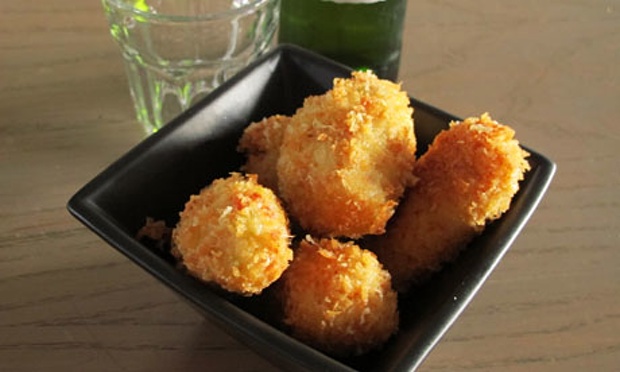
Felicity's perfect ham croquetas. Photograph: Felicity Cloake
It's customary to start any discussion of croquetas with a wry side-swipe at their Franco-British cousins, the potato croquette (or croquet potatoes as I believed them to be called until relatively recently, due to a perceived similarity to the mallet used in that fine English game). I refuse to be drawn into this – it's a long time since I came across one of those crispish orange cylinders of mashed potato pleasure, and frankly, I regret their disappearance from the national diet.
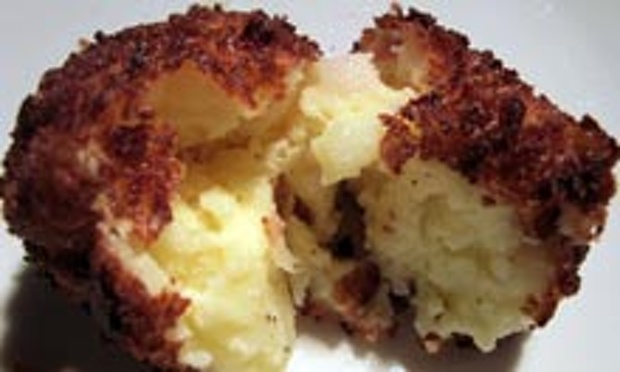
An old fashioned British potato croquette. Photograph: Felicity Cloake
That said, I am prepared to concede that the appearance of Spanish croquetas on these shores goes some way to making up for it – being fried, starchy and assertively salty they're pretty damn perfect in tapas terms. Made from a stiff béchamel, rather than mashed potato, they need to be eaten hot – so hot you burn your fingers on the crisp breadcrumb exterior as you rush to bite into the molten centre.
There are innumerable variations on the croquetas, all with their particular fans – David Eyre, of London's Eyre Brothers, is passionate about the superiority of the salt cod croquette above all others, while Hugh Fearnley-Whittingstall suggests using them as a vehicle for leftover roast chicken – but my heart lies with croquetas de jamón. Creamy béchamel is the perfect foil for morsels of intensely savoury Spanish ham: a plate of croquetas and a cold glass of fino sherry is pure, deep-fried happiness indeed.
Mash v béchamel
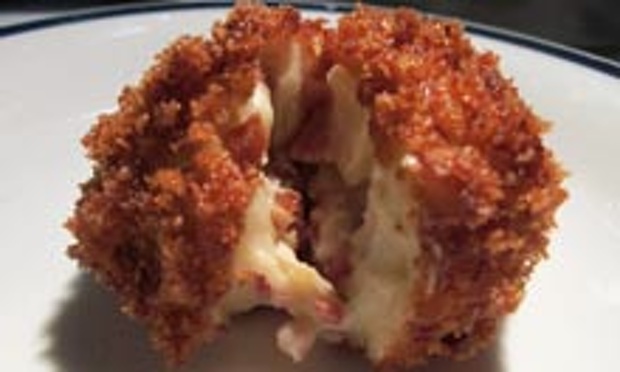
Barrafina recipe ham croqueta. Photograph: Felicity Cloake
Old habits die hard, and I'm delighted to come across a strange hybrid croquette / croquetas recipe on the website of a Spanish ham producer. Mashed potato is mixed with lard, cream and egg yolks, and then folded with whisked egg white, presumably to lighten the texture, before being moulded around a "gobbet" (tasty) of ham, breaded and fried.
For comparison's sake, I make the simplest traditional recipe I can find, from the Barrafina cookbook. It's prefaced with the reassuring note that these "particularly delicious" croquetas have been tinkered about with in the restaurant kitchen for years, "and this is now as close to perfection as we can get". I gently fry chunks of ham in butter and olive oil, then stir in flour, and finally hot milk, until I have a thick white sauce which, when cool, is stiff enough to roll into balls, crumb and deep-fry.
Trying the two together points up the deficiencies in my beloved croquettes. Despite the rich ingredients, the potato version seems stodgy and bland beside the surprisingly light, outrageously piggy filling that oozes from the crisp shell of the Barrafina croquetas. Fusion food fail, as the internet would say.
Béchamel nuts and bolts
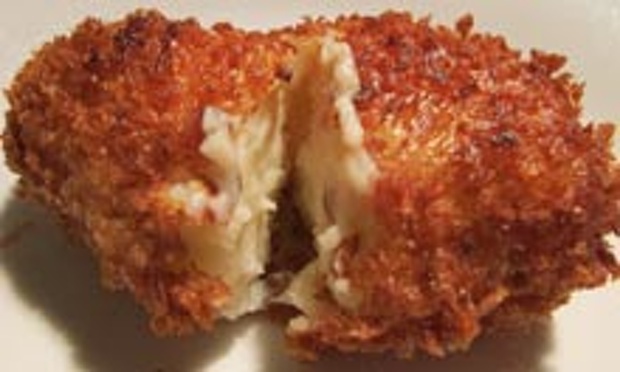
Movida recipe ham croqueta. Photograph: Felicity Cloake
While the Barrafina recipe seems designed to create as bland a canvas for the ham as possible, others prefer a more assertively flavoured sauce. The recipe used at MoVida, a Melbourne restaurant claimed by one Australian magazine to serve the country's best tapas, simmers the milk with bay leaves and a short length of ham bone before whisking it into a plain and cornflour roux studded with chopped onion. Sadly I'm unable to lay my hands on a proper jamón bone for this operation, but I do manage to beg one with prosciutto provenance from a local Italian delicatessen – yet, to be honest, the whole thing tastes more of the aromatics than the ham in any case. It's like something I'd put on top of a lasagne – and that can't just be down to the nationality of the pig concerned.
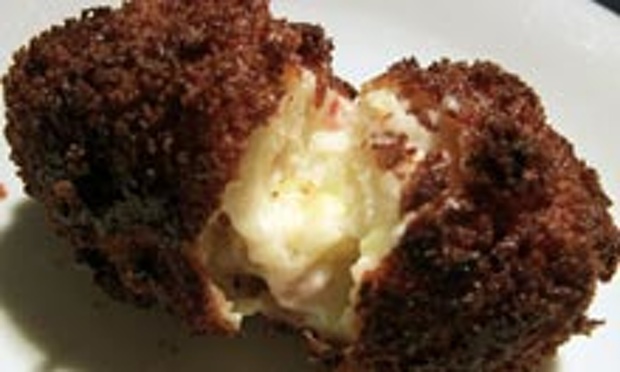
José Pizarro recipe ham croqueta. Photograph: Felicity Cloake
Although I don't like the onion used by MoVida and Martha Stewart in their white sauces, the leeks substituted by José Pizarro are a revelation, their sweetness chiming perfectly with the saltiness of the ham. Pizarro also uses all olive oil in place of a butter / oil mix, which he says gives it a better flavour, and mixes his milk with a little ham stock, but I prefer the bland creaminess of the butter and plain milk in Barrafina's recipe as a counterpart to all that porkiness.
With typical American excess, Martha Stewart melts grated Manchego cheese into her sauce – but I'm beginning to understand this dish should be all about the ham. To that end, I've decided to add it in two batches: one at the beginning, to infuse the béchamel, and one stirred in at the end, so it retains all its own character – cured ham seems to lose a bit of punch when cooked.
MoVida have me cooking – and stirring – my béchamel for 40 minutes, by which time, thanks to the cornflour, it's so thick it's all I can do to move the wooden spoon around the pan. This makes the cooked croquetas stodgy, almost like arancini: the looser mixtures used by Pizarro and Barrafina give a much lighter result. The chopped hard-boiled egg white the Australians stir in doesn't help the texture either.
Frying
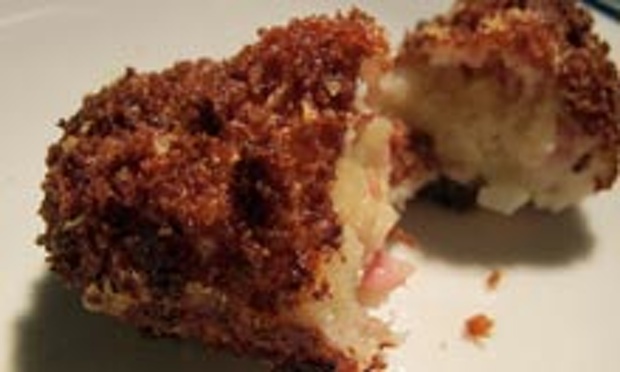
Martha Stewart recipe ham croqueta. Photograph: Felicity Cloake
Flouring your hands to roll the chilled croquetas mixture before breading, as recommended by José Pizarro, makes things much easier, but I love the Japanese panko breadcrumbs suggested by MoVida, which make an already crunchy exterior even crisper. (Because panko are flaked, they have a larger surface area than normal breadcrumbs, which makes them crisper, and also, according to Matthew Fort, less greasy too. Which basically makes these a health food.)
After dismissing Martha Stewart's cheesy croquetas, I have to admit that adding a little grated Manchego to the crumbs is a more subtle alternative which gives the breadcrumbs a great flavour as well as a satisfying crunch. Although it probably makes them rather less healthy, panko or not.
Finally, although generally I favour neutral oils for frying, on this occasion, I think olive oil is worth the expenditure – the flavour is complementary, rather than distracting. A litre bottle should be fine, and you can filter it and use it again should the call of croquetas prove difficult to ignore: in fact these are ideal for parties, because they need to be made in advance, and then fried to order. Although they are almost too good to share.
Perfect croquetas
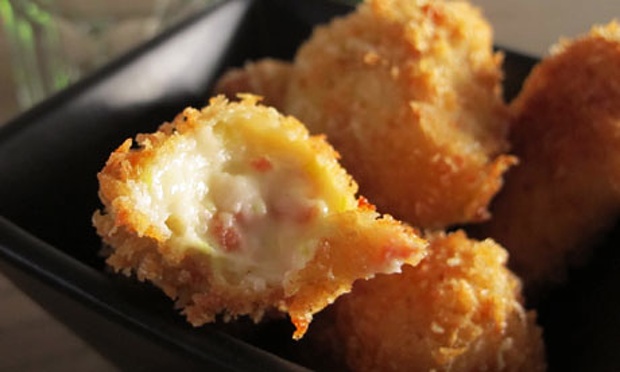
Felicity's perfect ham croquetas. Photograph: Felicity Cloake
Makes about 15
-
100g cured Spanish ham, preferably in 1 chunk
2 tbsp olive oil
60g unsalted butter
½ small leek, finely diced
60g plain flour
500ml whole milk, hot
Nutmeg, to grate
2 free-range eggs, beaten
150g panko breadcrumbs
25g manchego or other hard cheese, finely grated
1 litre olive oil, to fry
1. Dice your ham as finely as possible. Heat the oil and butter in a medium, heavy-bottomed saucepan over a medium heat and, when the butter melts, add the leek and and fry gently for a minute, then add 70g ham and cook until the leek has softened, and the ham fat has begun to melt.
2. Turn the heat down, gradually stir in the flour and cook gently, stirring regularly, until it loses its raw flavour – this should take about 8–10 minutes.
3. Gradually stir in the hot milk, beating it in well, until you have a smooth paste. Cook for another 15 minutes until it has the consistency of smooth mashed potato, then fold through the rest of the ham and season to taste with a grating of nutmeg and some black pepper (you won't need any salt). Put the béchamel in a bowl and allow to cool, then cover, pressing the clingfilm on to the surface of the sauce to prevent a skin from forming, and refrigerate for at least 2 hours.
4. Put the beaten eggs into a bowl, and the breadcrumbs and cheese into another. With floured hands, roll spoonfuls of the mixture into cylinders and dip these into the egg, then roll in the breadcrumbs until well coated.
5. Heat the olive oil in a large pan to 180C, or until it begins to shimmer. Prepare a plate lined with kitchen roll. Fry the croquetas in batches for a couple of minutes until golden all over, then lift out with a slotted spoon and serve at once.
Are croquetas the ultimate tapas dish – and if so, what's your favourite filling? What do you like to drink with them, and whatever happened to the potato croquette?